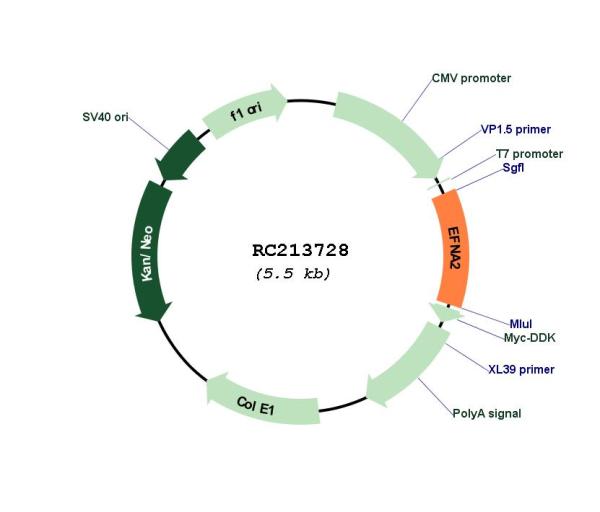Ephrin A2 (EFNA2) (NM_001405) Human Tagged ORF Clone
CAT#: RC213728
EFNA2 (Myc-DDK-tagged)-Human ephrin-A2 (EFNA2)
ORF Plasmid: tGFP
Lentiviral Particles: DDK DDK w/ Puro mGFP mGFP w/ Puro
AAV Particle: DDK
"NM_001405" in other vectors (6)
USD 198.00
Specifications
| Product Data | |
| Type | Human Tagged ORF Clone |
| Tag | Myc-DDK |
| Symbol | Ephrin A2 |
| Synonyms | ELF-1; EPLG6; HEK7-L; LERK-6; LERK6 |
| Vector | pCMV6-Entry |
| E. coli Selection | Kanamycin (25 ug/mL) |
| Mammalian Cell Selection | Neomycin |
| Sequence Data |
>RC213728 representing NM_001405
Red=Cloning site Blue=ORF Green=Tags(s) TTTTGTAATACGACTCACTATAGGGCGGCCGGGAATTCGTCGACTGGATCCGGTACCGAGGAGATCTGCC GCCGCGATCGCC ATGGCGCCCGCGCAGCGCCCGCTGCTCCCGCTGCTGCTCCTGCTGTTACCGCTGCCGCCGCCGCCCTTCG CGCGCGCCGAGGACGCCGCCCGCGCCAACTCGGACCGCTACGCCGTCTACTGGAACCGCAGCAACCCCAG GTTCCACGCAGGCGCGGGGGACGACGGCGGGGGCTACACGGTGGAGGTGAGCATCAATGACTACCTGGAC ATCTACTGCCCGCACTATGGGGCGCCGCTGCCGCCGGCCGAGCGCATGGAGCACTACGTGCTGTACATGG TCAACGGCGAGGGCCACGCCTCCTGCGACCACCGCCAGCGCGGCTTCAAGCGCTGGGAGTGCAACCGGCC CGCGGCGCCCGGGGGGCCGCTCAAGTTCTCGGAGAAGTTCCAGCTCTTCACGCCCTTCTCCCTGGGCTTC GAGTTCCGGCCCGGCCACGAGTATTACTACATCTCTGCCACGCCTCCCAATGCTGTGGACCGGCCCTGCC TGCGACTGAAGGTGTACGTGCGGCCGACCAACGAGACCCTGTACGAGGCTCCTGAGCCCATCTTCACCAG CAATAACTCGTGTAGCAGCCCGGGCGGCTGCCGCCTCTTCCTCAGCACCATCCCCGTGCTCTGGACCCTC CTGGGTTCC ACGCGTACGCGGCCGCTCGAGCAGAAACTCATCTCAGAAGAGGATCTGGCAGCAAATGATATCCTGGATT ACAAGGATGACGACGATAAGGTTTAA >RC213728 representing NM_001405
Red=Cloning site Green=Tags(s) MAPAQRPLLPLLLLLLPLPPPPFARAEDAARANSDRYAVYWNRSNPRFHAGAGDDGGGYTVEVSINDYLD IYCPHYGAPLPPAERMEHYVLYMVNGEGHASCDHRQRGFKRWECNRPAAPGGPLKFSEKFQLFTPFSLGF EFRPGHEYYYISATPPNAVDRPCLRLKVYVRPTNETLYEAPEPIFTSNNSCSSPGGCRLFLSTIPVLWTL LGS TRTRPLEQKLISEEDLAANDILDYKDDDDKV |
| Chromatograms |
CHROMATOGRAMS
 Sequencher program is needed, download here. |
| Restriction Sites |
SgfI-MluI
Cloning Scheme for this gene
Plasmid Map

|
| ACCN | NM_001405 |
| ORF Size | 639 bp |
| OTI Disclaimer | The molecular sequence of this clone aligns with the gene accession number as a point of reference only. However, individual transcript sequences of the same gene can differ through naturally occurring variations (e.g. polymorphisms), each with its own valid existence. This clone is substantially in agreement with the reference, but a complete review of all prevailing variants is recommended prior to use. More info |
| OTI Annotation | This clone was engineered to express the complete ORF with an expression tag. Expression varies depending on the nature of the gene. |
| Product Components | The ORF clone is ion-exchange column purified and shipped in a 2D barcoded Matrix tube containing 10ug of transfection-ready, dried plasmid DNA (reconstitute with 100 ul of water). |
| Reconstitution | 1. Centrifuge at 5,000xg for 5min. 2. Carefully open the tube and add 100ul of sterile water to dissolve the DNA. 3. Close the tube and incubate for 10 minutes at room temperature. 4. Briefly vortex the tube and then do a quick spin (less than 5000xg) to concentrate the liquid at the bottom. 5. Store the suspended plasmid at -20°C. The DNA is stable for at least one year from date of shipping when stored at -20°C. |
| Reference Data | |
| RefSeq | NM_001405.4 |
| RefSeq Size | 642 bp |
| RefSeq ORF | 642 bp |
| Locus ID | 1943 |
| UniProt ID | O43921 |
| Cytogenetics | 19p13.3 |
| Protein Families | Druggable Genome |
| Protein Pathways | Axon guidance |
| MW | 23.88 kDa |
| Gene Summary | This gene encodes a member of the ephrin family. The protein is composed of a signal sequence, a receptor-binding region, a spacer region, and a hydrophobic region. The EPH and EPH-related receptors comprise the largest subfamily of receptor protein-tyrosine kinases and have been implicated in mediating developmental events, particularly in the nervous system. Based on their structures and sequence relationships, ephrins are divided into the ephrin-A (EFNA) class, which are anchored to the membrane by a glycosylphosphatidylinositol linkage, and the ephrin-B (EFNB) class, which are transmembrane proteins. Posttranslational modifications determine whether this protein localizes to the nucleus or the cytoplasm. [provided by RefSeq, Jul 2008] |
Documents
| Product Manuals |
| FAQs |
| SDS |
Resources
Other Versions
| SKU | Description | Size | Price |
|---|---|---|---|
| RC213728L1 | Lenti ORF clone of Human ephrin-A2 (EFNA2), Myc-DDK-tagged |
USD 600.00 |
|
| RC213728L2 | Lenti ORF clone of Human ephrin-A2 (EFNA2), mGFP tagged |
USD 600.00 |
|
| RC213728L3 | Lenti ORF clone of Human ephrin-A2 (EFNA2), Myc-DDK-tagged |
USD 600.00 |
|
| RC213728L4 | Lenti ORF clone of Human ephrin-A2 (EFNA2), mGFP tagged |
USD 600.00 |
|
| RG213728 | EFNA2 (tGFP-tagged) - Human ephrin-A2 (EFNA2) |
USD 500.00 |
|
| SC127873 | EFNA2 (untagged)-Human ephrin-A2 (EFNA2) |
USD 300.00 |
{0} Product Review(s)
Be the first one to submit a review






























































































































































































































































 Germany
Germany
 Japan
Japan
 United Kingdom
United Kingdom
 China
China





